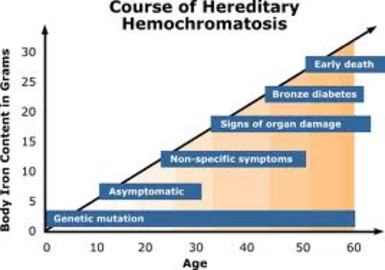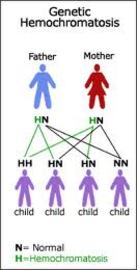Introduction

Hemochromatosis is a genetic condition that causes the body to absorb too much iron. The overload of iron usually accumulates in the heart, liver and pancreas. The later stages of Haemochromotisis can result in heart failure and many other serious diseases. There is no cure for Haemochromotosis, but the standard treatment is the removal of iron from the blood.
History
Normal iron absorption is 10 percent, but patients with Haemochromotosis absorb 30 percent of the iron they ingest. The body is unable to handle this overload and takes extra measures. The extra iron is usually disbursed to other major organs, like the liver. Once the extra iron is in an organ, it can’t be eliminated naturally. The overload of iron will damage the organ and it will not be able to function properly. The Mayo Clinic considers Haemochromotisis to be one of the most common genetic disorders in the United States.
The symptoms of Haemochromotosis appear in men around 30 to 50 years of age and in women older than 50 years of age. Abdominal pain and fatigue are the first symptoms to be seen and are followed by high blood sugar, arthritis and low thyroid function.
The later stages of Haemochromotosis can cause liver scarring or cirrhosis of the liver. Cirrhosis can then cause other complications like toxins that cause cognitive function, fluid within the abdomen and liver failure. An increase in developing liver cancer is also a risk. When the heart contains excess iron, an irregular heartbeat can develop, which can lead to heart failure. Diabetes can be brought on by an extra amount of iron in the pancreas can lead to diabetes and too much iron in the skin can cause a bronze or grayish tint.
Features

As stated earlier, there is no cure for Haemochromotosis, but treatment can delay and at times prevent organ damage. The most-used treatment is therapeutic phlebotomy, and any treatments needed for complications. Therapeutic phlebotomy is similar to donating blood. Blood is removed intravenously, until the patients iron level returns to normal. The amount removed is usually about a pint, and depends on the patient’s age, health and iron level. Most of the time blood is removed twice a week to allow the iron levels to decrease, and this treatment needs to be continued for the entire life of the patient. Once iron levels are controlled, the therapeutic phlebotomy treatments are reduced to six times a year. As with many other diseases, lifestyle changes are necessary. Not to add to any liver damage, avoid heavy drinking of alcohol. Avoid foods that are high in iron and vitamins that contain iron. Vitamin C helps the body's iron absorption, so limit your intake of vitamin C.
Tips and comments
Since Hemochromatosis is a genetic disease, screening should be performed on all family members. Early screening can detect the disease early, and treatment can occur before there is any organ damage. If you are the first of the family to be diagnosed, make sure and let other family members know, so that they can be screened. Contact a physician if you experience any of the symptoms described in this article.